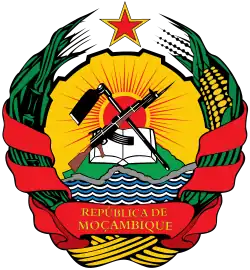_and_after_(March_20th)_(32489828117).jpg.webp)
Mozambique is one of the most vulnerable countries to climate change.[1][2][3] With a large proportion of the population living in low-lying areas, intensifying tropical cyclones, floods and storm surges are a significant threat.[4][3] A 2015 study in Climatic Change estimated that climate change will contribute to the national economy being up to 13% smaller in 2050 compared to a fictional scenario without it, and that GDP is likely to shrink.[5]
The government of Mozambique and civil society have identified areas for mitigation and adaptation, such as early warning systems for storms, investment in flood defences, resettlement schemes for at-risk communities and rebuilding destroyed settlements with improved disaster-resilient standards.[3][6]
References
- ↑ "UNSDG | Cyclone Gombe: Impact of climate change on women and girls in Mozambique". unsdg.un.org. Retrieved 2023-10-26.
- ↑ Caux, Hélène (10 November 2022). "Displaced people join efforts to adapt to climate change in Mozambique". UNHCR.
- 1 2 3 Wadekar, Neha (2021-11-01). "The good and the bad of Mozambique's climate crisis response". The New Humanitarian. Retrieved 2023-06-26.
- ↑ "Mozambique". www.climatelinks.org. 2023-06-09. Retrieved 2023-06-26.
- ↑ Arndt, Channing; Thurlow, James (2015-05-01). "Climate uncertainty and economic development: evaluating the case of Mozambique to 2050". Climatic Change. 130 (1): 63–75. doi:10.1007/s10584-014-1294-x. ISSN 1573-1480.
- ↑ Artur, Luis; Hilhorst, Dorothea (2012-05-01). "Everyday realities of climate change adaptation in Mozambique". Global Environmental Change. Adding Insult to Injury: Climate Change, Social Stratification, and the Inequities of Intervention. 22 (2): 529–536. doi:10.1016/j.gloenvcha.2011.11.013. ISSN 0959-3780.
